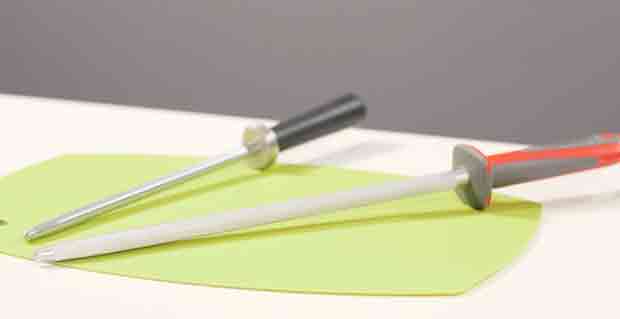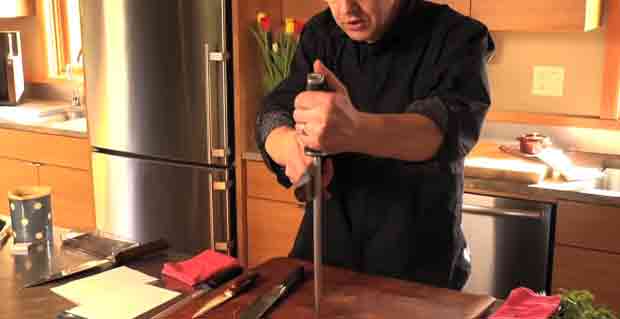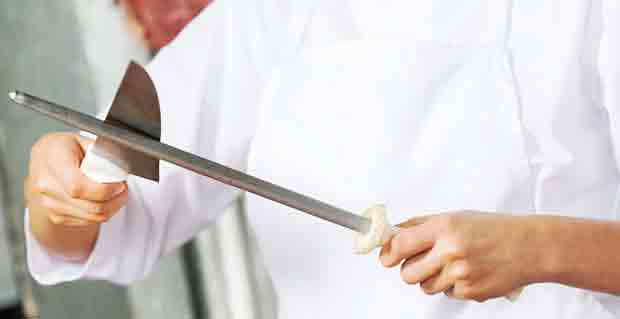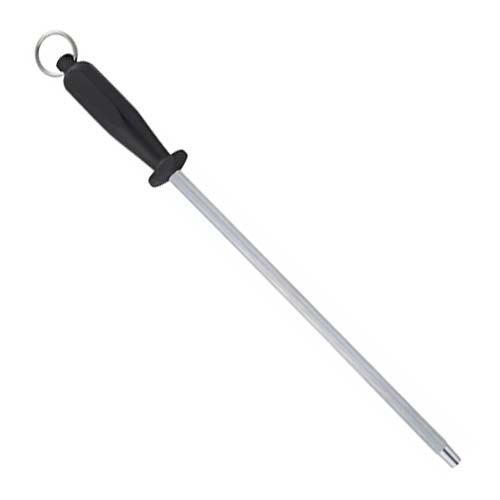The knife is the hardest working tool in the kitchen.
It’s the tool you need to reach for when you have to slice and dice the ingredients you want to use for cooking. You must also have a good knife on hand if you want to properly serve food. Claiming those presentation points is possible only if the knife in your possession is of great quality.
In a pinch, a knife can even be used to tear open packages, although it’s best to keep that to a minimum if you want to preserve the quality of your knife.
Over time though, the knife will still need help to continue working as well as it previously did. To do that, you will need to have a honing steel. With the best honing steel, even the most frequently used knife in your kitchen can retain its edge and remain in service for an impressive amount of time.
Product | Name | Editor's Rating | Prices |
|---|---|---|---|
5 out of 5 | |||
5 out of 5 | |||
4.5 out of 5 | |||
4 out of 5 | |||
4.5 out of 5 |
To find out how to acquire the honing steel that best suits your needs, please continue reading through the reviews and tips included in this article.
6 Best Honing Steel Reviews
1. Winware by Winco Sharpening Steel
You want an extended working surface with your honing steel. With that longer surface, you can more easily run the knife on it to execute the honing process properly.
What’s immediately striking about the Sharpening Steel from Winware by Winco is that it features that long working surface you want to have.
To be more specific, the surface itself extends to a foot-long. Just to make things completely clear, only the working surface is 12 inches long. The handle does not factor into that measurement.
Don’t worry though, because the handle is also five inches long. You can grip it easily, which is useful once it comes time for you to hone the edges of your knife.
This honing steel is also easy to clean, so don’t hesitate to use it.
Key Features:- Honing steel features a 12-inch working surface
- Handle included is also five inches long
- The steel used for the working surface is grooved
2. Utopia Kitchen Honing Steel
The folks at Utopia Kitchen have their own honing steel.
Similar to the item listed above, this is another honing steel that features a 12-inch working surface. We’ve already talked about how important it is to have that extended working surface, so it’s nice to have it present again here.
The surface itself is pretty durable. It will hold up well to continued usage. The surface is also grooved and that can help with the more efficient honing of the blade of your knife.
The feature that sets this honing steel apart from the numerous other options on the market is its handle. The handle fits snugly into your coiled hand and it features a rubber bottom that will prevent it from accidentally slipping from your grasp. You won’t experience any significant amount of discomfort even if you have to use this honing steel for a long time.
The feature that sets this honing steel apart from the numerous other options on the market is its handle. The handle fits snugly into your coiled hand and it features a rubber bottom that will prevent it from accidentally slipping from your grasp. You won’t experience any significant amount of discomfort even if you have to use this honing steel for a long time.
Key Features:- 12-inch working surface included with this honing steel
- Working surface is grooved
- Handle is ergonomically designed
3. Messermeister Ceramic Rod Knife Sharpener
The previous two honing rods we reviewed feature a steel surface for conditioning your knife’s edge. The offering from Messermeister makes use of a different material.
More specifically, the folks at Messermeister have decided to use ceramic to create their honing rod.
The ceramic material used to create Messermeister’s honing rod provides it with additional durability. As long as you maintain it properly, this honing rod should be able to last significantly longer than the more conventional honing steel.
The manufacturers have not skimped on the ceramic. This honing rod still features a 12-inch working surface that will make it easier to use.
It’s also worth noting that the handle included with this honing rod is quite comfortable. You don’t have to worry about your hands cramping up as you use it.
The only real drawback to this honing rod is the price. If you don’t have a lot of money to spend, this is probably not the honing rod you should get.
Key Features:- Working surface is made out of highly durable ceramic
- Ceramic working surface is 12 inches long
- Handle does not introduce any additional strain
4. Wusthof Knife Sharpening Steel
We’re going back to the sharpening steels now with this Wüsthof creation. However, this works differently from the ones we have already discussed.
So, what separates Wüsthof’s honing steel from the many other options on the market?
Its unique feature is that it is a magnetic item. That magnetic feature comes in very handy because it draws in the metal fibers from your knife. Since the honing rod is supposed to realign the edges of your knife, that magnetic feature will make accomplishing that task significantly easier.
This item is not without its flaws however.
Instead of a 12-inch working surface, this Wüsthof product only provides you with a 10-inch honing rod. That surface is still long enough that you should be able to work with it properly, but it can be difficult to do so at times.
Key Features:- Steel working surface is magnetized
- Comes with a slip-resistant handle
- Easy-to-clean honing steel
5. ARCCI Diamond Knife Sharpening Rod
Honing rods can be difficult to use especially for those who are not very experienced in the kitchen. If you mistakenly use a honing rod, there’s a chance that you’ll just end up ruining the knife itself. That’s why the Diamond Knife Sharpening Rod from ARCCI is a great option to pick up for those who are still trying to get used to honing their blades.
The working surface featured by this honing steel is smoother than what you’ll see on most competitors. That’s an important point of distinction because you won’t ruin the edges of the knife you’re working on even if you are unable to use the honing rod properly right away.
Once again though, the working surface is on the shorter side at only 10 inches. On top of that, this honing steel is not as durable as some of the other alternatives, so you may get better value out of other products.
Key Features:- Working surface is remarkably smooth
- This honing steel will not emphasize the mistakes you make
- Protective ring is included to shield you from harm
6. ZWILLING J.A. Henckels Pro Sharpening Steel
The Pro Sharpening Steel from ZWILLING J.A. Henckels is a user-friendly model, the kind of item that you will want to have on hand if you’re not experienced with maintaining knives.
It features a curved working surface that feels more natural. The knife will glide along the surface easily and all you will really have to do is to guide it. The specially designed handle provides additional assistance. It will aid significantly with the sharpening process.
This honing steel is also made out of quality materials. You don’t have to worry about it suddenly becoming unfit to work after only using it for a few months.
Unfortunately, the working surface is very short at just nine inches and that may cause you to make some mistakes while honing your knife.
Key Features:- Working surface is curved
- Honing steel is fashioned from quality materials
- Cleaning up this honing steel is a very easy process
The Different Factors to Look at before You Purchase a Honing Steel

1. The Material Used
Honing rods are typically made from one of three different materials, with those being steel, diamond, and ceramic.
Steel honing rods are the ones that will be the easiest to find. Honing steels are durable and they can be cleaned very easily. Honing steels also come in varied forms as they may feature rounded, square, or grooved surfaces.
Diamond honing rods actually make use of both diamonds and steel. The steel coating placed over the rod is remarkably smooth while the diamonds are included to act as a kind of abrasive. Diamond honing rods will work to sharpen your knives a bit, but if you just need something for honing the blade, these tools may prove to be too abrasive.
Ceramic honing rods come in as many forms as the steel rods and they also offer some sharpening like the diamond rods. The downside to the ceramic rod is that it can break easily if it slips from your hand and falls to the ground.
2. The Form of the Handle
The ideal honing rod handle will feature both a safety guard and an ergonomic design. The safety guard is there to protect your fingers just in case your knife slips. The ergonomic design is an important feature because it will guard against your hands growing strained.
3. The Length of the Honing Steel
You want a long working surface on your honing steel. The good news here is that most honing steels will provide you with that. Most honing steels have working surfaces that measure at 10 or 12 inches. A honing steel with a surface that long should be easy to use.
How can You Find the Best Honing Steel for Your Kitchen?
Many of us assume that as long as a knife can slice through what you put in front of it, then that means that it is still good to go. You don’t need it to cut through solid stone after all. It just has to be able to handle the basic assortment of ingredients.
That’s the wrong mindset to have with regards to knives.
A knife is a tool that requires diligent upkeep. If you don’t put in the effort to maintain it, then it will fall way short of your expectations.
This is where the honing steel can come in and help you out immensely.
The honing steel is the item you need above everything else for the purposes of properly maintaining your kitchen knife.
If you’ve been carrying on inside your kitchen without a honing steel, then it’s time to change that.
Degree of Difficulty Attached to Using the Honing Steel

Speaking of ease of use, that’s another factor you need to take into account before you buy any honing steel. If you want the easiest ones to use, look for those specific honing steels that come with built-in guiding features.
Maintenance Required for the Honing Steel
Just like your knives have to be maintained properly for them to last for a long time in your kitchen, you have to do the same thing for your honing steel.
It doesn’t take much to clean and maintain a honing steel, as we will discuss in just a bit. Once the cleaning is done, you can just store it according to how it has been designed.
You should know that the ceramic honing rods are the toughest ones to maintain due in part to them being brittle. Avoid those if you don’t want to spend too much time maintaining a honing steel.
Cleaning Requirements for the Honing Rod
After you finish using a honing rod, you have to complete a few steps to clean it properly.
The first thing you need to do is to grab a clean washcloth and then wipe the honing rod thoroughly after using it. Failing to wipe down the honing rod risks allowing small pieces of metal to get stuck in it. This is an even greater concern if the honing rod features a ridged working surface.
You will also have to wash the honing rod every now and then. To do that, run the honing rod under some hot water and use some soap and a cloth to scrub it clean. Avoid being too rough with the scrubbing or else the rod may get scratched. Be patient with the scrubbing because that’s the only way you can ensure that the honing rod will be cleaned the right way.
Ceramic rods will require more time and effort from you in order for them to be cleaned correctly. That’s because the knife you’re honing may end up leaving some marks on it. You will have to make use of an erasure if you want your ceramic honing rod to be free from the metallic marks that could be left by the knife.
Price of the Honing Rod
If you want to save money on your honing rod, you can do that by purchasing one of the honing steels. It may also come as a bit of a surprise, but the diamond honing rods are also quite affordable. The ceramic honing rods are typically the most expensive options available.
Warranty Offered with the Honing Rod
Manufacturers offer varied warranties for honing rods. Before you buy any specific honing rod, make sure to check out the warranty. Doing that will ensure that you will be able to avoid a bad deal.
Make it a point to look for honing rods that have longer warranties.
Also, you need to read through the terms of warranty and see if the manufacturers have identified specific knives that cannot be used with the honing rod. If you don’t take the time to check the fine print, you could end up unknowingly voiding the warranty.
How can You Find Honing Steel that will Work Best?
To do that, you need to look at several factors. Consider what material has been used to make the honing steel. The material used is going to greatly impact how the honing steel will affect the edges of your knife.
It’s also important to pay attention to what material is used for the handle and how it is designed. The way the handle is designed is going to determine how easy the honing steel will be to use.
If you don’t have the biggest budget to work with, it’s important to consider all the characteristics of the honing steel you’re eyeing to find out if it will be a good fit inside your kitchen.
How Exactly does a Honing Steel Work?

Think for a second about how the knife is supposed to work. When it slices through a piece of meat, a fruit, or a vegetable, the blade of the knife will then end up making contact with the cutting surface below. If you’re using a cutting board, then the blade will hit that surface.
Now, imagine how many times the blade of your knife makes contact with that solid surface.
It doesn’t really matter how well made your knife is or how sturdy the blade may be, inevitably the edges of the knife will move. The movements will hardly be noticeable at first, but over time, they will affect the performance of the knife itself.
When the edges of the knife have migrated too far from their original position, the performance of the blade will greatly suffer.
A good honing steel will address that issue.
The honing steel will work to effectively realign the blade. It will pull the edges of the knife back into their original position. If that is done properly, then the edges of the knife should become capable of cutting and slicing properly again.
One important thing to remember here is that most honing steels are designed just for realigning the blades of the knives. Honing steels won’t be able to do much good if the edges themselves have grown dull. At that point, you will probably need a different tool to sharpen the knife or you could also opt to get a new knife for your kitchen.
How Often Do I Have to Hone the Edges of My Knife?
Unfortunately, there is no set amount of time that needs to pass in between honing sessions. If you want to keep your knife in prime working condition at all times, then you simply have to pay close attention to how it performs whenever you use it.
If the knife is gliding across the item you are trying to cut, then there’s obviously no need to break out the honing steel. Once you experience some difficulty while cutting, that is the time when you will want to take out the honing steel and give your knife a few passes over it.
Don’t be surprised if you have to hone your knife more than once a day just to get it working right again. By the way, if you find that your knife suddenly needs to be honed more frequently, that probably means that it will have to be sharpened in the not too distant future, so make sure you have a whetstone ready.
What are Some Important Tips to Remember When Using a Honing Steel?
After watching some tutorials that focus on how to correctly use a honing steel, you should have a good idea of how that needs to be done. However, there are still important things you need to keep in mind if you want to get the most out of this valuable kitchen tool.
The first tip you need to always keep in mind is that it’s okay to use a honing steel the moment an issue pops up with your knife. As soon as you notice your knife having difficulty with the regular cutting motions, it’s time to reintroduce it to the honing steel and get it back in working order.
Next up, you cannot be too rough with your knife when you are using it against the honing steel. Many of us assume that applying more pressure will help get the realigning process done faster, but that is not the case at all. By using too much force to hone the knife, all you’re doing is increasing the chances that the blade will be ruined.
Also, you need to take your time when you are using a honing steel. Speed will have no effect on how well the honing process goes. It’s best to take your time, ensure that the blade and the honing steel are aligned properly, and just go at a pace you’re comfortable at.
By following the aforementioned tips, you can be sure that each honing session will end up producing great results.
What’s the Difference Between Honing and Sharpening?
It’s easy to see why so many people think that honing and sharpening is the same thing. Those words share a somewhat similar definition and that means they are referring to the same process, right?
To be clear, honing and sharpening are not the same thing. For one, you need different tools to pull them off. Honing is accomplished using a honing steel while sharpening is typically done with the aid of a whetstone.
Furthermore, honing is only designed to realign the blade of the knife. Sharpening goes beyond that and uncovers a new edge of the knife.
How can You Tell if Your Knife Needs to be Honed?
People with tons of experience working in the kitchen will be able to notice right away if the knife they’re using has to be honed. Obviously, not everyone has that type of kitchen experience.
You can keep a close eye on the performance of the knife and still struggle to detect any change in how it works.
Don’t worry too much if you are having trouble seeing the drop-off in your knife’s performance.
To make figuring out the sharpness level of your knife easier, you can put it through some tests.
The Paper Test
The first test you can run is pretty straightforward and all you need is your knife and a piece of paper. It doesn’t even have to be a special piece of paper. Just pick out a sizable sheet of paper you typically write on.
Grab the paper using your non-dominant hand and hold it up in front of you. Pick up your knife next using your dominant hand and then position it at one of the edges of the paper. Use the knife to slice through a portion of the paper while using a minimal amount of force.
If the knife is unable to clear the sheet of paper cleanly, then the blade likely needs to either be honed or sharpened.
The Produce Test
The next test you can try out involves your knife and any fruit or vegetable with a soft interior. A citrus fruit will work great for this test.
Place the fruit or vegetable of your choice on top of the cutting board and then hold it using your non-dominant hand. Take hold of your knife next and start to cut through that piece of produce.
The knife should have no trouble making its way through that fruit or vegetable if it’s suitably sharp. Anything less than that means you probably have to hone or even sharpen the knife.
It is worth noting that you can use other, harder materials to test the sharpness of your knife. I personally avoid doing that because I want to protect my knives as much as possible.
How can I Properly Store My Honing Steel?
Just like any other piece of kitchen equipment, you need to properly store your honing steel if you want it to last for a long time.
Thankfully, the honing steel itself will likely tell you how it should be stored.
Some of the honing steels on the market are magnetized. If you want to, you can get a steel hanging rack and just stick the honing rod to it to keep it protected.
Many honing steels feature loops on their handles. You can store those by just hanging them up somewhere in your kitchen.
If your honing rod is neither magnetized nor equipped with a hook, then you should keep it in a drawer. Just make sure you are not overcrowding it in there.
The Different Benefits You can Enjoy If You Regularly Use a Honing Steel
They Help You Save Money
With no honing steel in your kitchen, the lives of your knives will be shortened considerably. When it gets to the point where the knife can no longer cut cleanly, you may have no other option than to purchase a replacement if you don’t have a honing steel.
They are User-Friendly
When you watch seasoned chefs use honing steels, it can seem like you need years of practice before you can utilize them correctly. That is not the case at all however. Take some time out to watch a few tutorials regarding honing steel usage. It won’t take you long before you pick up the basics, and once you do that, honing should prove to be easy.
They Work
You’re not buying snake oil when you put money down for a honing steel. This particular tool has been proven to work and it will realign the edges of your knife in a hurry. It doesn’t even require a lot of effort on your part to make the honing steel work, so don’t be afraid to get one.
A Step by Step Guide for Using a Honing Steel
Using a honing steel is not a complicated process, but there are still specific things you need to do if you want to perform this task correctly.

1. Put the honing steel on top of your kitchen counter. Keep the handle in the air while making sure that the other end is making contact with the countertop.
2. Pick up your knife and hold it just below the handle of the honing steel.
3. Create a 15-degree angle between the honing steel and your knife. The tip of your knife should be pointing upward.
4. While maintaining that 15-degree angle, slide the knife down the length of the honing steel. Move the knife by applying only a moderate amount of pressure. Pull the knife towards your body as you reach the end of the honing steel.
5. Replicate that honing motion about five times. Once that’s done, work the other edge of the knife and repeat the honing motion five more times.
6. Wipe down both the knife and the honing steel.
7. Test your newly honed knife. If it responds well, clean it using soap, running water, and a wash cloth. If the knife is still dull, repeat the honing process again. Should the honing process still prove ineffective after repeating it, you may need to use a whetstone instead of a honing rod.
8. Clean the honing steel using soap, running, and a washcloth.
9. Store both the knife and the honing steel.
Your trusty knife does so much to help you in the kitchen, so it’s only right that you do what you can to keep it in the best shape possible. The honing steel will help you maintain the edges of your favorite knife.
Hopefully, this article has helped you identify exactly which type of honing steel you need to have inside your kitchen. By having the right honing steel in your kitchen, you can effectively extend the life of your knife and the time you spend in the kitchen moving forward should be more enjoyable.
The knife is the hardest working tool in the kitchen, but it can only keep going if it’s paired up with the right honing steel.



![Best Under Cabinet Paper Towel Holder in 2022 [Top 6 Models] Best Under Cabinet Paper Towel Holder in 2022 [Top 6 Models]](https://mykitchening.com/wp-content/uploads/2022/04/Best-Under-Cabinet-Paper-Towel-Holder-211x150.webp)
